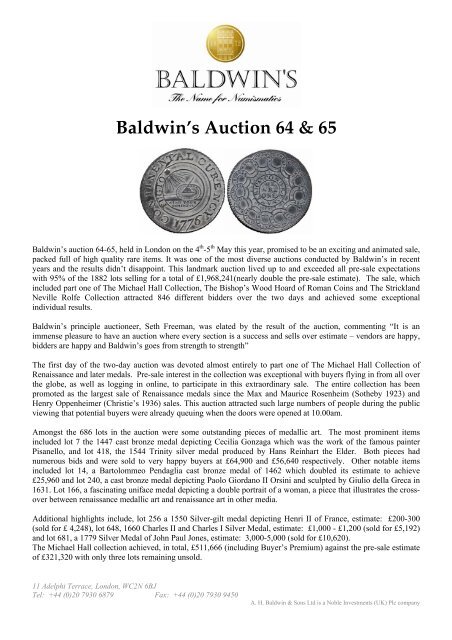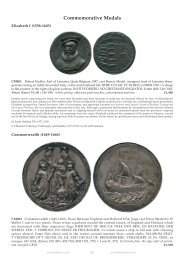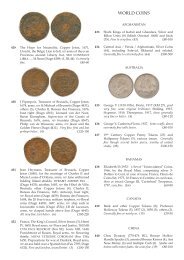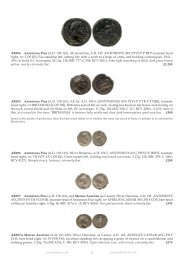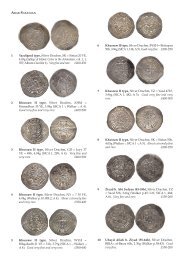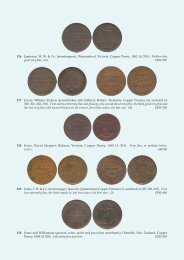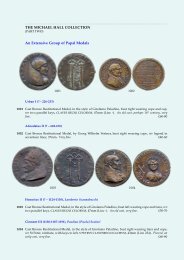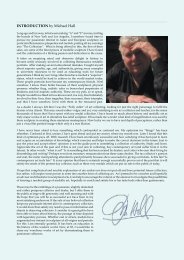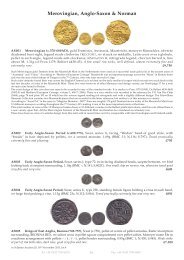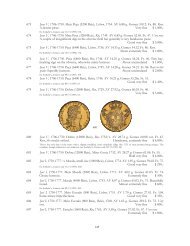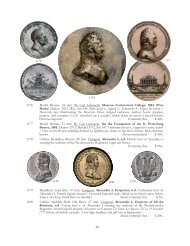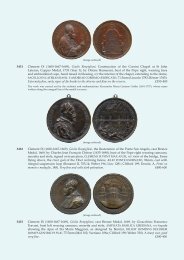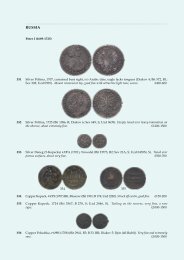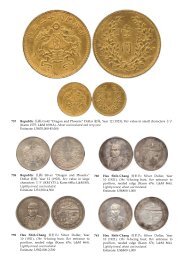Baldwin's Auction 64 & 65
Baldwin's Auction 64 & 65
Baldwin's Auction 64 & 65
You also want an ePaper? Increase the reach of your titles
YUMPU automatically turns print PDFs into web optimized ePapers that Google loves.
Baldwin’s <strong>Auction</strong> <strong>64</strong> & <strong>65</strong><br />
Baldwin’s auction <strong>64</strong>-<strong>65</strong>, held in London on the 4 th -5 th May this year, promised to be an exciting and animated sale,<br />
packed full of high quality rare items. It was one of the most diverse auctions conducted by Baldwin’s in recent<br />
years and the results didn’t disappoint. This landmark auction lived up to and exceeded all pre-sale expectations<br />
with 95% of the 1882 lots selling for a total of £1,968,241(nearly double the pre-sale estimate). The sale, which<br />
included part one of The Michael Hall Collection, The Bishop’s Wood Hoard of Roman Coins and The Strickland<br />
Neville Rolfe Collection attracted 846 different bidders over the two days and achieved some exceptional<br />
individual results.<br />
Baldwin’s principle auctioneer, Seth Freeman, was elated by the result of the auction, commenting “It is an<br />
immense pleasure to have an auction where every section is a success and sells over estimate – vendors are happy,<br />
bidders are happy and Baldwin’s goes from strength to strength”<br />
The first day of the two-day auction was devoted almost entirely to part one of The Michael Hall Collection of<br />
Renaissance and later medals. Pre-sale interest in the collection was exceptional with buyers flying in from all over<br />
the globe, as well as logging in online, to participate in this extraordinary sale. The entire collection has been<br />
promoted as the largest sale of Renaissance medals since the Max and Maurice Rosenheim (Sotheby 1923) and<br />
Henry Oppenheimer (Christie’s 1936) sales. This auction attracted such large numbers of people during the public<br />
viewing that potential buyers were already queuing when the doors were opened at 10.00am.<br />
Amongst the 686 lots in the auction were some outstanding pieces of medallic art. The most prominent items<br />
included lot 7 the 1447 cast bronze medal depicting Cecilia Gonzaga which was the work of the famous painter<br />
Pisanello, and lot 418, the 1544 Trinity silver medal produced by Hans Reinhart the Elder. Both pieces had<br />
numerous bids and were sold to very happy buyers at £<strong>64</strong>,900 and £56,<strong>64</strong>0 respectively. Other notable items<br />
included lot 14, a Bartolommeo Pendaglia cast bronze medal of 1462 which doubled its estimate to achieve<br />
£25,960 and lot 240, a cast bronze medal depicting Paolo Giordano II Orsini and sculpted by Giulio della Greca in<br />
1631. Lot 166, a fascinating uniface medal depicting a double portrait of a woman, a piece that illustrates the crossover<br />
between renaissance medallic art and renaissance art in other media.<br />
Additional highlights include, lot 256 a 1550 Silver-gilt medal depicting Henri II of France, estimate: £200-300<br />
(sold for £ 4,248), lot <strong>64</strong>8, 1660 Charles II and Charles I Silver Medal, estimate: £1,000 - £1,200 (sold for £5,192)<br />
and lot 681, a 1779 Silver Medal of John Paul Jones, estimate: 3,000-5,000 (sold for £10,620).<br />
The Michael Hall collection achieved, in total, £511,666 (including Buyer’s Premium) against the pre-sale estimate<br />
of £321,320 with only three lots remaining unsold.<br />
11 Adelphi Terrace, London, WC2N 6BJ<br />
Tel: +44 (0)20 7930 6879 Fax: +44 (0)20 7930 9450<br />
A. H. Baldwin & Sons Ltd is a Noble Investments (UK) Plc company
The first day of the sale concluded with session one of auction <strong>65</strong>, a selection of 132 British and World medals.<br />
The most prominent lot sold of the section was lot 1131, an 1848 Silver Slave’s Medal for Good Conduct, which<br />
achieved £944 against an estimate of £200-250.<br />
The Bishop’s Wood Hoard of Roman coins was amongst the lots in the Ancient section which opened the second<br />
day of the sale. The 1,661 coins and the restored jar that contained them were sold in 10 lots including the purpose<br />
built cabinet in which they were housed. The lots drew worldwide interest amongst the ancient numismatic<br />
community prior to the auction as the coins had remained uncirculated and had been in the family of the landowner<br />
since their discovery in 1895. In total the 10 lots (lots 1152-1162) achieved £46,9<strong>64</strong>. The lots were all won by the<br />
same bidder so we are very happy to report that this part of the hoard remains intact.<br />
A fine selection of 98 British coins comprised the middle section of the morning session with lot 1243, a superb<br />
example of the 1<strong>65</strong>0 Commonwealth Gold Unite selling for £11,800 and paving the way for some exceptional<br />
results from the final section of the first Session, The Strickland Neville Rolfe Collection.<br />
The Reverend Neville Rolfe spent a lifetime accumulating and immaculately preserving his numismatic collection<br />
which brilliantly represented a snapshot of the tastes and interests of an educated English country gentleman and<br />
divine of the Victorian era. The entire group of items remained untouched and in the hands of his descendants<br />
since his death in 1852. The strength of the coin market for quality pieces and fresh material ensured that the presale<br />
estimate was smashed with every one of the 258 lots in the collection selling for a total of £259,845 against a<br />
pre-sale estimate of £107,210. The most notable lots included key rarities, such as the pattern “Incorrupta” crown<br />
(lot 1405), one of only eighteen known to have been struck, and the “Three Graces” crown, one of the most<br />
important and majestic coins of the English series (lot 1406), which sold for £25,960 and £29,500 repectively<br />
against estimates of £10,000-£15,000. Lot 1452, an undated Charles II, St. Patrick’s coinage Farthing, achieved an<br />
exceptional hammer price of £3,776. Lot 1474, a collection of 239 Norfolk 17 th Century tokens, complete with<br />
accompanying notebook, sold well over estimate for £14,750. The notebook itself pre-dates any of the reference<br />
works on which we rely today and exposes Rolfe as somewhat of a pioneer in this field, which is sure to have<br />
contributed to the excellent result achieved for the lot. By far the most compelling piece in the collection was a<br />
stunningly preserved 1776 Continental Dollar (lot 1588, pictured above) which sold in the room for a staggering<br />
£63,720.<br />
The second session of the day began with a strong World coin selection which included a small group (lots 1738-<br />
1749) of fantastic Polish gold coins which more than doubled their estimate, realising £122,508. Other highlights<br />
of the world coin section included lot 1622, a Sultan Selim I Gold Altin and lot 16<strong>65</strong>, a Chandragupta II Gold<br />
Dinar which sold for £5,900 and £8,024 respectively. A small collection of Japanese Oban and Koban comprised<br />
part of a collection of coins of the Orient. Lot 1905, a 1725 Kyoho Oban Kin, was one of the unique and valuable<br />
pieces in the auction and attained a price of £23,600 while lot 1939, a rare and very fine Korean 1906 Kuang Mu<br />
Gold 20-Won, achieved £37,760.<br />
Bidding in the final session of the day was fierce and exceptionally lively both in the room and online as 256 lots of<br />
Russian coins from a Nobleman’s Collection went under the hammer. Confirming that the Russian market is still<br />
remarkably robust the 256 lots sold for a total hammer price of £429,402 with high achieving results on a number<br />
of lots. Most notable amongst them were lot 1973, the classic Russian rarity, a Novodel 1736 Hedlinger type<br />
Rouble which went for £23,600 and lot 2058, and extremely fine and rare 1797 Gold Ducat which sold for £52,510,<br />
against its estimate of £15,000-20,000.<br />
Baldwin’s, now in their 16 th year of trading as an auction house, have built on their exceptional reputation as a long<br />
standing coin dealer to produce auctions that achieve remarkable results. Due to the increasing costs of organising<br />
auctions and the additional promotion that Baldwin’s undertakes on behalf of its vendors the decision was taken to<br />
increase the buyer’s premium from 15 to 18%. This is the first rise in buyer’s premium at Baldwin’s for more than<br />
10 years Baldwin’s is proud that this fee of 18% is still less than many of our UK counterparts but is sufficient to<br />
allow Baldwin’s to continue to offer the high levels of expertise that their customers have become used to over the<br />
years.<br />
Full sale results can be found online at www.baldwin.co.uk or at www.sixbid.com<br />
For press enquiries please contact Caroline Newton on +44 (0)20 7930 9808 or at carolinenewton@baldwin.co.uk.<br />
11 Adelphi Terrace, London, WC2N 6BJ<br />
Tel: +44 (0)20 7930 6879 Fax: +44 (0)20 7930 9450<br />
A. H. Baldwin & Sons Ltd is a Noble Investments (UK) Plc company
Sale Highlights<br />
7 Renaissance Italy. Antonio de Pucci, called Pisanello (c.1394-1455). Cecilia Gonzaga (1426-1451), cast<br />
Bronze Medal 1447, half length bust of the sitter left, her hair tightly bound with a ribbon, wearing an embroidered<br />
gown and pleated skirt, CICILIA VIRGO FILIA IOHANNIS FRANCISCI PRIMI MARCHIONIS MANTVE, rev in a<br />
rocky landscape below a crescent moon, a semi-nude young woman rests her hand on the head of a unicorn lying<br />
beside her, to the right, a stele, with a floral ornament fixed to its top, bears the inscription OPVS PISANI PICTORIS<br />
M CCCC XLVII [the work of Pisanello the painter 1447], 72.5mm (Hill, Corpus 37; Arm I, 5, 12; Currency of Fame<br />
7a, this piece; Pollard 20; Kress 17; Syson & Gordon 3.31a, b). An extremely fine original cast of the highest quality, a<br />
masterpiece of renaissance medallic art.<br />
Cecilia Gonzaga was celebrated as a scholar despite her few years. Wishing to pursue her studies rather than marry she<br />
elected to join a convent but this met with opposition from her father who had independently arranged for her to marry<br />
Oddantonio da Montefeltro of Urbino. Oddantonio reportedly financed his debauched and excessive lifestyle by<br />
imposing heavy taxes and was commonly despised. Cecilia refused to marry him. He was ultimately assassinated. The<br />
medal’s meaning is clear in its intention to portray the innocence and chastity of the sitter, and the representation of a<br />
unicorn in the form of a goat alludes to her acquisition of knowledge. The composition of the medal, the simplicity of the<br />
obverse and the symbolism of the reverse, make students of Italian art consider it one of the very best renaissance medals.<br />
Estimate: £60,000-80,000<br />
Hammer: £55,000<br />
14 Renaissance Italy. Sperandio da Mantova (c.1425-1504). Bartolommeo Pendaglia (d. 1462), cast Bronze<br />
Medal c.1462, bust in profile to the left, wearing flat-topped hat and pleated robe, BARTHOLOMAEVS PENDALIA<br />
INSIGNE LIBERALITATIS ET MUNIFICIENTIAE EXEMPLV[M], rev nude male figure seated right, on cuirass<br />
and arms, holding spear and sphere, perhaps a large pearl, a thin drape across his shoulders, his left foot resting on a<br />
sack overflowing with coins, CAESARIANA LIBERALITAS, and BELOW OPVS SPERANDEI, 88mm (Hill, Corpus<br />
356; Arm I 71, 32; Pollard 78). An extremely fine contemporary cast. Pendaglia was one of the wealthiest<br />
men in Ferrara. When the Holy Roman Emperor Frederick III visited Ferrara in 1434 he attended the wedding of<br />
Pendaglia and Marcherita Costabili giving her a large pearl and him a knighthood. The reverse type draws on this<br />
event and the Liberalitas Augusti type in Roman coinage. Sperandio da Mantova (c.1425-1504). Sperandio was the son<br />
of a goldsmith and worked in cities throughout northern Italy, including Venice where he died. He was prolific and a<br />
master of the portrait medal. From The Micheal Hall Collection.<br />
Estimate: £8000-10,000<br />
Hammer: £22,000<br />
166 Renaissance Italy. Alfonso Ruspagiari (1521-1576). Bust of a Woman viewed by a face in profile, uniface<br />
Lead Medal, sculptural bust of a woman shown in three-quarter profile, in the centre of an oval field, wearing a<br />
narrow girdle around which a veil is intertwined, she wears earrings and a pendant hanging on a ribbon from her<br />
neck, her hair is wound with a twisted cord, the artist’s signature AF can be seen on the sitter’s truncated right<br />
arm, from the scrolled frame a viewer’s face is depicted opposite the face of the sitter (Pollard 519; Kress 450;<br />
Arm I 216/5; Currency of Fame 73, this piece). Nearly extremely fine and an original cast. Writing in The<br />
Currency of Fame, Mary L Levkoff notes that this piece is not technically a medal. As such it illustrates the crossover<br />
between renaissance medallic art and renaissance art in other media; consider also the medals that follow this lot.<br />
Levkoff suggests that the theme of the work calls to mind a painting by Fra Filippo Lippi in the Metropolitan Museum<br />
of Art, in New York, and discusses the themes of Pygmalion and Vanitas. All of these factors strongly support the<br />
opinion that these pieces were designed for artisitic display not as historical references. The present ambiguous double<br />
portrait continues to fascinate the student.<br />
Estimate: £2000-3000<br />
Hammer: £7,800<br />
11 Adelphi Terrace, London, WC2N 6BJ<br />
Tel: +44 (0)20 7930 6879 Fax: +44 (0)20 7930 9450<br />
A. H. Baldwin & Sons Ltd is a Noble Investments (UK) Plc company
240 Renaissance Italy. Giulio della Greca (active 1618-1633). Paolo Giordano II Orsini (1591-1<strong>65</strong>6), Duke of<br />
Bracciano, Principal of Piombino, Seigneur of Elba, antiquarian, numismatist and musical patron, large cast Bronze<br />
Medal, 1631, bust right wearing ruff collar over armour with Orsini bear’s head decoration on breast- and shoulderplates,<br />
PAVL IORD II BRACC DVX D G ANG COM S R I P, rev boat rowed hard to left by four oarsmen and a<br />
coxswain, Fame above and cherub blowing wind, CONTRA VENTOS ET VNDAS, dated in exergue between sprays<br />
of roses, 1631, decorative border to both sides of diminutive rose heads, 98mm (T&V, Bargello, 40-43, 19; Mazz II,<br />
pl.CXI, 6; Clifford 253). An exceptional cast, extremely fine and well patinated. Pollard, in La Medaglia con ritratto<br />
di epoca barocca in Italia, was the first to identify the signature “Iul D Gra” below the truncation. The medal was at<br />
one time believed to have been by Bernini and then by Cormano. Clifford suggests that the reverse could represent a<br />
competition between the Orsini and their rivals the Colonna family. The use of the rose probably derives from the<br />
tradition established by Pope Leo IX in 1052, to present a rose to the Orsini family at each Pentacost. Further<br />
references may be found in Clifford. Giulio Della Greca (active 1618-1633). Neapolitan artist working in Rome<br />
Estimate: £1200-1500<br />
Hammer: £5,200<br />
256 FRANCE. Attributed to Jacques II Rouaire (before 1520-1571). Henri II (1519-1547-1559), the<br />
Cession of Boulogne by the English to the French, solid cast Silver-gilt Medal, 1550, draped bust left, HENRICVS<br />
II FRANCORVM REX, rev Perseus rescuing Andromeda from the sea-monster, 8L8; −,8 50?∗60, 48mm (BMC<br />
Jones Vol I, 54-56; Pollard [2007] 626; Kress 545; Mazz II, 140; Arm II, 248, 2). An early and possibly<br />
contemporary cast, very fine. Pollard leaves the attribution as “probably French with Italian or Netherlandish<br />
influence”. Boulogne was sold to the French for 400,000 Crowns.<br />
Estimate: £200-300<br />
Hammer: £3,600<br />
418 Germany and Bohemia. Hans Reinhardt the Elder (active 1535-1568). Hans Reinhart the Elder (c.1510-<br />
1581), The Trinity or Moritz-pfennig, Silver Medal 1544, on an ornate throne decorated with floral design, God<br />
the Father, seated facing, holding orb and sceptre, wearing an imperial crown and jewelled cope, before him Christ<br />
on the crucifix, surmounted by a Dove representing the Holy Spirit, angels attend in prayer on clouds either side of<br />
the throne, above them the heads of cherubim ascending to the heavens, PROPTER SCELVS MEI PERCVSSI<br />
EVM ESAIAE LIII [I have smitten him for my people’s transgression, Isaiah 53], rev two angels standing on a<br />
cloud support a tablet inscribed with an excerpt from the Athanasian Creed and a prayer to the Trinity, around<br />
REGNANTE MAVRITIO D G DVCE SAXONIAE ZC GROSSVM HVNC LIPSIAE H R CVDEBAT AN O<br />
MDXLIIII MENSE IANV [in the reign of Maurice, by the grace of God, Duke of Saxony etc. Hans Reinhart cast<br />
this medal in Leipzig in the month of January 1544], 100mm (Habich 1962, pl.207, 1 and pl.209, 1; Scher 127).<br />
Beautifully cast and finely chased, iridescently toned, the lightest wear to some high points and without damage, a<br />
medal of the finest quality. This medal is without question a masterpiece of Northern European Renaissance art. In<br />
work produced for Maurice’s cousin, Johann Friedrich, Reinhart had incorporated symbols and references<br />
sympathising with the Lutheran movement, clearly stating the Elector’s religious affiliation. In this piece, through the<br />
incorporation of the Athanasian Creed with its theological relevance to both Protestants and Catholics alike at this<br />
juncture, Maurice attempts, through art, a reconciliation between the two churches. Highly prized then as now, copies<br />
of the medal were cast in 1556, 1561, 1569 and 1574, the last three in the name of Elector August, Maurice’s<br />
successor.<br />
Estimate: £60,000-80,000<br />
Hammer: £48,000<br />
<strong>64</strong>8 Great Britain. Charles II (1660-1685). Charles II and Charles I, Silver Medal, 1660 in two plates, by Peter<br />
van Abeele, three-quarter facing bust of Charles I, in lace collar, CAROLVS D I, rev facing bust of Charles II in plain<br />
collar with medal on riband, CAROLVS D II, both fields richly decorated with a floral design, 70mm (MI i 449/33;<br />
Frederiks 23/24). Toned, extremely fine and very rare<br />
Estimate: £1200-1500<br />
Hammer: £4,400<br />
11 Adelphi Terrace, London, WC2N 6BJ<br />
Tel: +44 (0)20 7930 6879 Fax: +44 (0)20 7930 9450<br />
A. H. Baldwin & Sons Ltd is a Noble Investments (UK) Plc company
681 American Interest. John Paul Jones (1747-1792), The Capture of the British Frigate HMS Serapis by the<br />
USS Bonhomme Richard, Silver Medal 1779, for the ‘Comitia Americana’ series, by Augustin Dupré, uniformed<br />
bust right, his hair tied behind en queue, JOANNI PAVLO JONES CLASSIS PRAEFECTO, COMITIA<br />
AMERICANA, rev the naval engagement, HOSTIVM NAVIBVS CAPTIS AVT FVGATIS, AD ORAM<br />
SCOTIAE XXIII SEPT M DCCLXXVIIII, 55mm (Betts 568; Adams & Bentley, Ch 8; BHM 222, R2; MH 580;<br />
CP 105/22; Ford XIV, 203). Extremely fine.<br />
Estimate: £3000-5000<br />
Hammer: £9,000<br />
1131 Commemorative Medals By Subject. Slavery [Brazil], Morro Velho Gold Mines, Silver Slaves Medal for<br />
Good Conduct, c.1848, bare-footed slave stands with one hand outstretched, the other resting on anchor, rev MORRO<br />
VELHO – PREMIO DE BOA CONUCTA, 38mm (Cavalcanti 59). Very fine with deep tone, ‘clip’ mark to top edge<br />
from where suspension loop has been removed, extremely rare. A note with the medal states, “Morro Velho slave<br />
medal of Freedom … given by dying slave to a missionary. Given to me by an Old Lady as a parting gift when<br />
leaving Chiswick”. The image of the slave derived, perhaps, from C F Carter’s 1834 medal to commemorate the<br />
Abolition of Slavery. Viscondessa de Cavalcanti’s Catalogo das Medalhas Brazileiras, lists the medal under<br />
“Abolition of slavery” and attributes it to 1848. She also quotes “Sr Hopkin, president of the company in 1888” who<br />
said that by 1882 all but 28 had been emancipated. Morro Velho is a complex of gold mines located near the city<br />
of Nova Lima in the Minas Gerais state of Brazil, in operation since 1835, it is the world’s oldest continuously worked<br />
mine. The English-owned St John del Rey Mining Company was the largest slaveholder in the Brazilian province of<br />
Minas Gerais during the second half of the nineteenth century. The explorer Sir Richard Burton and his wife Lady<br />
Isabel, visited the mines and his account, Explorations in the Highlands of Brazil, published in 1869, tells of the<br />
fortnightly Slave Muster. He describes how on every other Sunday, early in the morning, over a thousand slaves, men,<br />
women and children, all dressed in a special wardrobe assigned by the superintendent (but bare-footed), gathered in<br />
front of the Casa Grande (big house) where the selected few were given medals, awards, and public recognition by the<br />
overseers.<br />
Estimate: £200-250<br />
Hammer: £800<br />
11 Adelphi Terrace, London, WC2N 6BJ<br />
Tel: +44 (0)20 7930 6879 Fax: +44 (0)20 7930 9450<br />
A. H. Baldwin & Sons Ltd is a Noble Investments (UK) Plc company
1152 Ancient Coins. Roman Coins From The Bishop’s Wood Hoard. Brazilian Mahogany Cabinet, purpose-built<br />
by Spink & Son, drop-front, bevelled-glazed lifting lid, with two interior compartments, the left with five coin trays,<br />
each with the capacity to hold 100 coins, and two deeper drawers, the right with space to house the pot; the cabinet on<br />
stand with carved claw-and-ball feet; cabinet dimensions 70cm x 36cm x 38cm; together with the heavily<br />
reconstructed pot, not of local (possible east Midlands) manufacture, that contained the hoard; also with offprints of<br />
the articles by Mary Bagnall-Oakeley, Numismatic Chronicle, vol XVI, 1896, pp.209-237, and Transactions of the<br />
Bristol and Gloucestershire Archaeological Society, vol.XIX, 1895, pp.399-420, the latter including the author’s<br />
handwritten list of institutions that had received parcels of coins from the hoard, dated March 1898. The trays<br />
of the cabinet containing 500 coins as follows: Divus Claudius Gothicus (d. AD 270), REQVIES OPTIMOR MERIT,<br />
emperor seated on curule chair, Rome, 317-318 (RIC 106) (1); Diocletian (AD 284-305), CONCORDIA MILITVM,<br />
Prince receiving Victory on globe from Jupiter, Antioch, c.296 (RIC VI 60a var) (1); Maximian (AD 286-305),<br />
CONCORDIA MILITVM, similar type, Alexandria, c.296-297 (RIC VI 46b) (1); Constantine I (AD 307-337),<br />
Treveri, 330-331 (RIC 525) (17), (RIC 526) (18), 332-333 (RIC 537) (46), (RIC 538) (12); BEATA<br />
TRANQVILLITAS, globe on altar inscribed VOT/IS/XX, Treveri, 321 (RIC 303) (1); SARMATIA DEVICTA,<br />
Victory, with trophy, Treveri, 323-324 (RIC 435) (1); CONSTAN/TINVS/AVG in three lines, Treveri, 326 (RIC 485)<br />
(1); SOLI INVICTO, Sol, Treveri (RIC -) (1); SOLI INVICTO COMITI, Sol, Lugdunum, 316 (RIC 53) (1);<br />
CONSTANTINI AVG around VO/TIS/XX in three lines, Lugdunum, 320 (RIC 91) (1); VIRTVS EXERCIT, VOT /<br />
XX, Lugdunum (uncertain mark) (1); Helena (mother of Constantine I), SECVRITAS REI PVBLICAE, Securitas,<br />
Treveri, 326 (RIC 481) (1), 327-328 (RIC 515) (1); Licinius I (AD 308-324), IOVI CONSERVATORI AVGG,<br />
Jupiter, holding Victory, Heraclea, 321-324 (RIC 52) (1), (RIC 54) (1); Nicomedia (RIC 44) (2), (RIC 49) (1); Cyzicus<br />
(RIC 18) (1); Alexandria (RIC 28) (2), (uncertain mark) (1); Urbs Roma (c.AD 330), wolf and twins, two stars above,<br />
Treveri (RIC 522) (4), (RIC 529) (85), (RIC 542) (41); Constantinopolis (c.AD 330), Victory on prow, with spear and<br />
shield, Treveri (RIC 523) (6), (RIC 530) (106), (RIC 543) (45); Constantine II (AD 337-340), Treveri, 330-331 (RIC<br />
527) (38), 332-333 (RIC 539) (19); IOVI CONSERVATORI AVGG, Cyzicus, 321-324 (RIC 19) (1); Constantius II<br />
(AD 337-361), Treveri, 330-331 (RIC 528) (18), 332-333 (RIC 540) (22); PROVIDENTIAE CAES, camp gate,<br />
Treveri, 326 (RIC 480) (1). Extremely fine or nearly so. (500)<br />
Estimate: £4,000-5,000<br />
Hammer: £10,200<br />
1243 British Coins. Commonwealth (1<strong>64</strong>9-1660), Gold Unite, 1<strong>65</strong>0, English shield within laurel and palm<br />
branch, initial mark sun, .THE.COMMONWEALTH.OF.ENGLAND., toothed border both sides, rev English and Irish<br />
shields, value above within beaded circle, date at top, .GOD.WITH.VS., 9.02g (N 2715; S 3208). A broad full round<br />
specimen with original mint bloom, a superb example, original die-engravers guide line still visible on the obverse<br />
encircling the legend, one light scratch above the obverse shield, otherwise extremely fine and a rarer date, all dates<br />
are very rare in this high grade.<br />
Estimate: £8000-10,000<br />
Hammer: £10,000<br />
11 Adelphi Terrace, London, WC2N 6BJ<br />
Tel: +44 (0)20 7930 6879 Fax: +44 (0)20 7930 9450<br />
A. H. Baldwin & Sons Ltd is a Noble Investments (UK) Plc company
1405 The Strickland Neville Rolfe Collection. British Coins. George III, Pattern Crown, the “Incorrupta”, 1817,<br />
struck in silver, by William Wyon, laureate and draped bust right, date below, W.WYON: below rear of drapery,<br />
GEORGIUS III D:G: BRITANNIARUM REX, last letter obscured by drapery, toothed border both sides, rev struck en<br />
medaille, crowned quartered shield of arms with a crowned escutcheon of the Arms of Hanover, INCORRUPTA<br />
FIDES VERITASQUE, edge plain (ESC 229 R4; L&S 159). Attractively toned with a few tiny blotches, mint state<br />
FDC, attractive and extremely rare. Lot 1199 from the J T Brockett auction in June 1823 is the first known record of<br />
one of these patterns being sold and a note there shows a total mintage of only 25 pieces. According to a manuscript<br />
note in one of the surviving copies of this sale, this may include the seven specimens struck in gold, leaving only 18<br />
struck in silver. Strickland Charles Edward Neville Rolfe was born in 1789, eldest son of General Neville of the<br />
Royal Artillery. He assumed the name and arms of Rolfe by royal warrant in 1837, upon receiving the bequest of the<br />
estates at Heacham and Sedgeford, from Edmund Rolfe, a distant relative who had no issue. Educated at Wadham<br />
College, Oxford, BA 1812, MA 1816, he was ordained in 1814. He became domestic chaplain to the Duke of Kent in<br />
1814 and to the Duke of Somerset in 1825. He was appointed vicar of Heacham in Norfolk in1838. His first wife,<br />
Agnes, was the only daughter of Henry Fawcett, MP for Carlisle. They married in 1814 and had five sons and four<br />
daughters. In 1833 he married Dorothy, widow of the Rev TT Thomason, Chaplain to the Honourable East India<br />
Company. Strickland Rolfe died in 1852. Heacham Hall was destroyed by fire in 1941, whilst being occupied by the<br />
RAF. The numismatic collection has remained in the hands of descendents and represents a snapshot of the tastes<br />
and interests of an educated country gentleman and divine. The English coins span three centuries and include some<br />
key rarities, such as the pattern “Incorrupta” and “Three Graces” crowns, as well as some rare and interesting coppers.<br />
It is amazing to think that these were probably acquired soon after they were issued, which would account for their<br />
remarkable state of preservation.<br />
Estimate: £10,000-15,000<br />
Hammer: £22,000<br />
1406 The Strickland Neville Rolfe Collection. British Coins. George III, Pattern Crown, the “Three Graces”,<br />
1817, struck in silver, by William Wyon, laureate head right, date below, W.WYON. below truncation,<br />
GEORGIUS III D:G: BRITANNIARUM REX F:D:, beaded border and linear circle both sides, rev struck en<br />
medaille, the Three Graces, personifying England, Scotland and Ireland, with national emblems, W.WYON to left<br />
of harp, FOEDUS INVIOLABILE, palm branch and paddle in exergue, edge plain (ESC 223 R2; L&S 152).<br />
Attractively toned with a few tiny blotches, a little cabinet friction to high points, good extremely fine, attractive<br />
and extremely rare.<br />
Estimate: £10,000-15,000<br />
Hammer: £25,000<br />
1452 The Strickland Neville Rolfe Collection. Ireland. Irish Coins. Charles II, St Patrick’s Coinage, Farthing,<br />
undated, first issued in 1670s, St Patrick with Patriarchal Cross driving away reptiles, church to right, QVIESCAT<br />
PLEBS, rev King David strumming harp, crown above, .FLOREAT REX., brass plug inserted at top, toothed border both<br />
sides, edge milled (DF 342; S <strong>65</strong>69). Toned, about extremely fine for issue and very rare this nice.<br />
Estimate: £300-400<br />
Hammer: £3,200<br />
1474 The Strickland Neville Rolfe Collection. British Tokens. Norfolk 17 th Century Tokens. The main collection<br />
as listed in the accompanying notebook (237 pieces). A few tokens are in fact not from Norfolk but are included here<br />
because they are listed. These misattributions are hardly surprising, as the reference works we rely on today were far<br />
in the future. Strickland Neville Rolfe was very much a pioneer in this field, and did an astonishing job amassing such<br />
a good collection, presumably working without a checklist. Items listed in the Notebook but no longer present are<br />
listed at the end of the lot. The Notebook also lists 39 18 th Century tokens which are now missing from the collection.<br />
Estimate: £4000-6000<br />
Hammer: £12,500<br />
11 Adelphi Terrace, London, WC2N 6BJ<br />
Tel: +44 (0)20 7930 6879 Fax: +44 (0)20 7930 9450<br />
A. H. Baldwin & Sons Ltd is a Noble Investments (UK) Plc company
1588 The Strickland Neville Rolfe Collection. World Coins. Pre-Federal America. Continental Dollar, 1776,<br />
pewter currency type, die axis ↑↑, twin olive leaf edge device, rarity 3, struck from late stage obverse die but with all<br />
details showing, 18.49g (N 1C; H 1A.3). Uncirculated. vastly superior to the J J Ford specimen (Part I, 14 October<br />
2003, lot 4) which realised US$46,000 (£27,750) . Strickland Charles Edward Neville Rolfe was born in 1789,<br />
eldest son of General Neville of the Royal Artillery. He assumed the name and arms of Rolfe by royal warrant in 1837,<br />
upon receiving the bequest of the estates at Heacham and Sedgeford, from Edmund Rolfe, a distant relative who had no<br />
issue. Educated at Wadham College, Oxford, BA 1812, MA 1816, he was ordained in 1814. He became domestic<br />
chaplain to the Duke of Kent in 1814 and to the Duke of Somerset in 1825. He was appointed vicar of Heacham in<br />
Norfolk in1838. His first wife, Agnes, was the only daughter of Henry Fawcett, MP for Carlisle. They married in 1814<br />
and had five sons and four daughters. In 1833 he married Dorothy, widow of the Rev TT Thomason, Chaplain to the<br />
Honourable East India Company. Strickland Rolfe died in 1852. Heacham Hall was destroyed by fire in 1941, whilst<br />
being occupied by the RAF. The numismatic collection has remained in the hands of descendents and represents a<br />
snapshot of the tastes and interests of an educated country gentleman and divine. The English coins span three centuries<br />
and include some key rarities, such as the pattern “Incorrupta” and “Three Graces” crowns, as well as some rare and<br />
interesting coppers. It is amazing to think that these were probably acquired soon after they were issued, which would<br />
account for their remarkable state of preservation.<br />
Estimate: £10,000-15,000<br />
Hammer: £54,000<br />
16<strong>65</strong> India. Gupta, Chandragupta II (c.375-414 AD), Gold Dinar, 7.80g, Lion-slayer/Lion retreating type, legend<br />
above king standing to front, head left, legs apart and with long sash at his waist, he holds an arrow in his left hand and<br />
with his right thrusts his bow towards a lion which has turned its back on him and is retreating, rev Sinhavikramah at<br />
right, tamgha above left, goddess seated facing on a lion walking to right, she holds a lotus flower in raised left hand<br />
and a riband in her right (BMC pl.IX, 12, published from the Mirzapur Hoard, Lucknow Museum; see also NC 1910<br />
p.406). An attractive coin, good very fine and extremely rare.<br />
Estimate: £4000-5000<br />
Hammer: £6,800<br />
1905 Japan. Kyoho Oban Kin, c.1725, 1<strong>65</strong>.4g, 153mm x 94mm, with JNDA Guaranty Certificate 20494, issued<br />
2007 (JNDA 09-08; F 5). Calligraphy restored, extremely fine and toned, rare.<br />
Estimate: £20,000-25,000<br />
Hammer: £20,000<br />
1939 A Collection Of Coins Of The Orient. Korea. Kuang Mu (1897-1907), Gold 20-Won, year 10 (1906),<br />
dragon, rev denomination within wreath (KM 1131; JNDA 18-13; F 1). Good very fine, rare. only 2506<br />
pieces struck<br />
Estimate: £25,000-30,000<br />
Hammer: £32,000<br />
1973 Anna (1730-1740). Rouble 1736 (St Petersburg), 26.81g, Hedlinger type, Novodel (Bit H228 (R3) var; Ilyin<br />
(50-Rubl); JRNS, 63, fig.12; Sev 1236A (RR); Uzd 0727 (RR)). Golden tone over prooflike surfaces, some reverse die<br />
rust and edge filed, otherwise good extremely fine, a classic Russian rarity.<br />
Estimate: £10,000-15,000<br />
Hammer: £20,000<br />
2058 Russian Coins. Paul I (1796-1801). Gold Ducat 1797 СМ-ГЛ, 3.49g, edge 6 (Bit 13 (R1); Fr 143; Sev<br />
363A (R); Uzd 0174 (S)). Minimal waviness, as its typical, wonderful mint lustre, good extremely fine and rare,<br />
especially with this edge variety.<br />
11 Adelphi Terrace, London, WC2N 6BJ<br />
Tel: +44 (0)20 7930 6879 Fax: +44 (0)20 7930 9450<br />
A. H. Baldwin & Sons Ltd is a Noble Investments (UK) Plc company
Estimate:£15,000-20,000<br />
Hammer: £44,500<br />
11 Adelphi Terrace, London, WC2N 6BJ<br />
Tel: +44 (0)20 7930 6879 Fax: +44 (0)20 7930 9450<br />
A. H. Baldwin & Sons Ltd is a Noble Investments (UK) Plc company
Notes to the Editor:<br />
• Established in 1872 A. H. Baldwin & Sons Ltd has over 100 years experience in servicing the numismatic<br />
industry.<br />
• Baldwin’s auction department was established in 1993 and has grown to hold between ten and twelve sales<br />
annually in London, New York and Hong Kong and specialise in all areas of Numismatics.<br />
• Baldwin’s broadcast all of their main auctions over the internet and provide a live bidding service through<br />
www.the-saleroom.com/baldwins<br />
• Prices quoted in the main body of the release are inclusive of Buyer’s Premium at 18%.<br />
11 Adelphi Terrace, London, WC2N 6BJ<br />
Tel: +44 (0)20 7930 6879 Fax: +44 (0)20 7930 9450<br />
A. H. Baldwin & Sons Ltd is a Noble Investments (UK) Plc company


